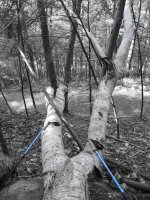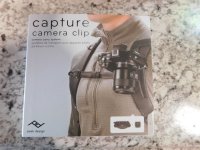However, the arguments became much less applicable to me when my frequency of those two types of paddling scaled way down and I became mostly a flat water day paddler and moving base camp paddler, as many here are.
You are absolutely correct. I very rarely use my Olympus Tough unless I'm on a canoe trip, which I haven't taken in years now. For day trips I don't feel the need to take pics and if I did my phone would probably be in my pocket.
I'd like to continue this discussion of various cameras for various usages.
When I lost my Pentax waterproof P&S camera in Alaska in 2013, I was already finished with serious whitewater paddling and suspected (correctly) that I was also done with extended wilderness trips. So, I wanted a camera that had better optics, zoom and macro capabilities than the waterproof models then available—more of a small "do everything" camera not only for canoeing, but also for photographing the women's basketball games I was then being hired to write about and photograph.
As I became much more of a flat water canoe day tripper, often on the same nearby routes, I found my photographic interests on these trips were not snapshots of new campgrounds, rivers or lakes, but rather closer investigations of flora, fauna and geology using zoom and macro closeups. The Nikon COOLPIX P7800, with a 2.0 lens, 7x optical zoom, good macro, and lots of SLR-like controls filled the bill nicely, using the small Pelican box in a canoe for waterproof protection.

It has an eyepiece as well as a screen. I use the eyepiece when outdoors.
I agree with Scott that an eyepiece is important to me for outdoor photography because LCD screens get all washed out by light. My old Pentax waterproof had an eyepiece and so does the Nikon P7800.
********************
I'm too cheap to buy more than one camera for my occasional serious photo forays, so I became sort of an amusing character as a credentialed photographer at the women's basketball NCAA tournament. Not only was I the oldest guy sitting in the gaggle of photographers at the endlines of the court, I was the one with the most ridiculous equipment.
Everyone else had very long zoom lenses and high speed motor drives on their high-end Nikon and Canon SLRs. The photographer from the AP would have all his photos immediately sent through the air to his colleague at the press table, who would edit the photos right away on a laptop and upload them to the AP website within minutes of their being taken.
Meanwhile, I was sitting there with my tiny Nikon compact, pictured in my post above. Perhaps I deserve the Guinness world record for NCAA photographer with the worst camera. Nevertheless, I captured the cover photo of Breanna Stewart for an internet magazine and also published a photo of the rebound that gave Kaleena Mosqueda-Lewis her only triple double.




